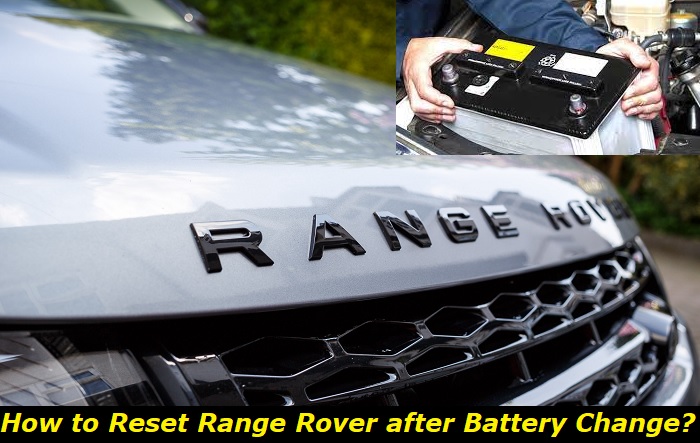You don't need to perform a Range Rover reset after a battery change unless in special cases. For example; how dead the previous battery was before you removed it or how long it took you to replace the dead battery. So as long as you do things right, your vehicle shouldn't need a reset.
No-power problems highlights
- Level of urgency:high
- DIY inspection:possible but complicated
- DIY repairs:possible but often complicated
- Can you drive?no
- Price of repairs:$50 - $250
- If ignored:no-start, nothing works
- Ways to fix:check the battery, connections, fuses

About Range Rover Battery Replacements
Some car owners utilize certain power sources (backup batteries) or code savers when changing their Range Rover batteries by hooking them up to the vehicle. This is to ensure that the vehicle's computer isn't corrupted or its settings aren't lost during the procedure.
However, the battery swapping procedure somewhat includes steps that would make the ECU (electronic control module) and battery reset themselves. The vehicle shouldn't lose its settings during the new installation. It should be perfectly fine.
So you should have no worries about resets on a Range Rover, especially if it's a recent model-year type. But you'll have a higher chance of needing a reset because of the issues that come with old-model Range Rovers. We've presented some instances in the next section.
Battery Replacement Procedure without a Reset
You may be fortunate not to experience any vehicle trouble after exchanging the old unit for a new one. This is even if your battery has run dead on many occasions. The unit may even be disconnected and put back numerous times, but your vehicle wouldn't have the special need for a reset.
However, you can only have a good chance of being that lucky if your Range is a recent model year and you do the replacement steps right.
If your Range Rover says "Charging System Fault" (described in this article), then you may need reprogramming in the dealership to get rid of faults and errors.
When You May Need To Perform a Reset on Old Model Year Range Rovers
These scenarios are for Range Rovers released as far back as 2007. With luck, you'll find the one that matches your situation here.
1) When the Steering Wheel Is Problematic
Try turning it totally left and then totally right. This may reset the air suspension and other modules. Avoid swapping out the battery while the ignition key is in the vehicle. Keep it away from the cabin! You may have to reprogram the steering wheel and seat memory if the key was within the car during the procedure.
2) When the Key Isn't Working after a Replacement
Leaving the headlights on overnight can drain the battery. Although this may not prompt a replacement in a situation where you can easily charge the unit. But whether you replace the unit or recharge it, the key could stop functioning. The steps below could prove to be useful in that regard:
- Step 1: Enter your Range and close all the doors.
- Step 2: Insert the key and rotate it to the "on" and "off" positions quickly then pull it out. These should be done in less than 5 seconds.
- Step 3: Push and hold the "unlock" button almost immediately or within half a minute of switching off the ignition.
- Step 4: Push the "lock" button three times while still holding the "unlock" button.
- Step 5: Release the "unlock" button.
- Step 6: Insert the key back into the ignition immediately and switch it on and off again. This is the end of the key fob synchronization procedure.
This problem may occur together with the steering wheel malfunction, where the wheel rests in a low position. Check your owner's manual for relevant information!
3) When You Change a Dead Battery
Changing a dead battery can cause many error codes to pop up when you restart the vehicle. Your Range will be misbehaving and it may get you so confused that you'd have to take it to the dealership. This is probably the best option for you in such a case.
The dealer will perform a reset on each module. And that's a significant amount of money to consider in paying for labor costs. Just take your checkbook along with you as a precaution.
You may be fortunate to have a sophisticated diagnostic scan tool at your disposal for the reset. The dealership visit and labor cost can be avoided if the scanner can read ALL the error codes and reset all the affected systems.
Scan tools that aren't advanced won't be able to read every fault code or reset all your Range's computers. But a dealership or auto repairer is most likely to have a scanner that will read all the errors. A basic diagnostic device may not be able to display as many as close to a hundred DTCs (diagnostic trouble codes).
Battery Reset on Range Rovers
1) Reasons for Range Rover Reset after Battery
- A fault in the unit
- Battery terminal corrosion
- Alternator problems
- Bad fuse box
- Defective ignition switch
- Damaged, worn, or loose cables and connections
- Malfunctioning BCM (body control module)
- Parasitic drain from other components when the vehicle is off
2) Common Symptoms
- Intermittent power loss
- Vehicle starting issues
- Malfunctioning infotainment system
- Faulty electrical parts
- Error codes
- CEL (check engine light) or MIL (malfunction indicator light) on
3) Affected Range Rover Models
- Evoque
- Velar
- Discovery
- Vogue
- Sport
4) Battery Reset Procedure
- Step 1: Switch off the vehicle and remove the key from the ignition.
- Step 2: Wear safety gloves and goggles.
- Step 3: Find the Battery under the hood.
- Step 4: Disconnect the negative terminal with a socket wrench.
- Step 5: Keep the negative cable away.
- Step 6: Disconnect the positive terminal and cable as you did for the negative.
- Step 7: Inspect and clean the terminals and battery posts diligently. Utilize a small towel or battery terminal cleaning brush for this with baking soda and water solution.
- Step 8: Reconnect the terminals.
- Step 9: Test the unit again to see if the reset was effective.
Range Rover Battery Maintenance and Replacement Culture
Doing the following will prevent premature battery changes or having to do resets after an exchange.
- Never Let the Battery Die
Avoid letting the battery die before charging it again. Get it juiced up to the max standard limit and in a healthy way when it becomes flat mistakenly. For example; leaving the headlights on overnight.
- Avoid Overusing a Repeatedly Dead Battery
Think of getting a new battery when you realize that the battery has been run dead too many times. This is because such a unit can develop faults of its own and affect other vehicle areas/components.
Old Range Rover starting batteries aren't designed for such stressful usage. That's the reason there are so many issues in the old-model years linked to battery condition.
- Don't Do a Swap Until All Systems Are Off
Your vehicle owner's manual states that the unit shouldn't be removed till all its systems are deactivated. And you should wait for about two minutes to be sure that this is done right.
- Make Sure the Old Battery is Fully Charged
A battery that's about to be changed should be fully charged first if possible. This ensures that there'll be no auto-reset issues after installing the new unit.
You can hook up another power source or backup battery to your Range's terminals if the old one can't be charged. Remember the code savers we mentioned earlier as well. That might be another choice alternative for you as well.
- Avoid Letting it Sit for Too Long
Online Range Rover repair forum threads contain a good number of stories where the vehicle user let the battery sit in their garages for weeks. You should know that keeping the battery unused for that long may not save it from power drainage.
Avoid doing this as it can have adverse effects on your Range. Although it's possible to leave the car sitting for weeks with the key in the ignition without the battery draining completely. That's in a normal case where there's no electronic malfunction draining the unit's power.
The battery will go dead after some time if there's a fault that's taking its power. For example; the fuel pump runs non-stop because of various potential factors. Another scenario is an internal battery short.
You could try hooking up a current meter to the system for a power drainage test. Find out the amount of current wasting away and see if the unit goes flat. The culprit might just be a battery fault.
Conclusion
It's advisable to let a trusted mechanic perform the Range Rover replacement job if you're not sure about what you're doing. The steps are easy and they can be done the DIY way without any hassle. But don't touch anything based on trial and error. The electrical components are prone to various faults!
Working batteries and their terminals is a risky business that poses risks to you, the unit, and the vehicle. Only go ahead with the procedure if you're confident of your knowledge of the electrical workings (battery connections) and overall vehicle repair expertise.
About the authors
The CarAraC research team is composed of seasoned auto mechanics and automotive industry professionals, including individuals with advanced degrees and certifications in their field. Our team members boast prestigious credentials, reflecting their extensive knowledge and skills. These qualifications include: IMI: Institute of the Motor Industry, ASE-Certified Master Automobile Technicians; Coventry University, Graduate of MA in Automotive Journalism; Politecnico di Torino, Italy, MS Automotive Engineering; Ss. Cyril and Methodius University in Skopje, Mechanical University in Skopje; TOC Automotive College; DHA Suffa University, Department of Mechanical Engineering






Add comment